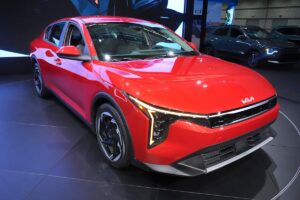Kia’s Strategic Surge in the Automotive Market
Kia, the South Korean automotive powerhouse, is making waves in the industry with impressive sales growth and an ambitious blueprint for the future. As part of the Hyundai Motor Group, Kia is not just riding the wave of consumer enthusiasm for its vehicles; it’s also strategically positioning itself as a leader in sustainable mobility.
In February, Kia America reported record sales, fueled by its popular gas-powered models, particularly the Telluride SUV and the burgeoning lineup of electric vehicles (EV), including the innovative EV6 crossover. This dual strategy caters to diverse consumer preferences, balancing traditional combustion engines with cutting-edge electric alternatives.
Steven Center, COO & EVP of Kia America, articulated his company’s vision concisely: “Our grand strategy is to be a leader in sustainable mobility.” This encompasses not just fully electric vehicles but also hybrid and plug-in hybrid solutions, showcasing Kia’s commitment to reducing its carbon footprint while fulfilling consumer demands. The brand cleverly embraces a broad portfolio that includes a refreshing mix of SUVs and sedans, such as the newly launched K4, a midsize sedan that reinforces Kia’s ongoing focus on passenger car segments, unlike some competitors who have shifted primarily towards SUVs.
U.S. Production Plans and Tariff Tactics
Kia’s growth trajectory includes significant investments in localized production. Over the past three decades, the automaker has invested billions in U.S. manufacturing, and it plans to ramp up EV production stateside, particularly in Georgia. Center highlighted this initiative, stating, "We’re going to be building EVs in Georgia… this is part of a plan we’ve had for a long time." With over 570,000 jobs tied to Kia and its suppliers in the U.S., the brand’s commitment to American manufacturing positions it well amidst shifting trade dynamics, especially with tariff considerations.
Uncertainties about tariffs loom, particularly following commentary from Ford’s CEO, Jim Farley, who argues that non-targeting of Kia and other international imports may create an uneven playing field. However, Kia seems prepared for potential changes, believing that their substantial U.S. manufacturing base will mitigate adverse impacts. Center remarked, “Tariffs will affect every brand differently… we’ve got our business plan, and we’re going to continue to work that plan to the best advantage of our customers.”
Expanding the EV Portfolio
Kia’s recent "Kia Day" event in Portugal underscores its commitment to innovation, featuring the unveiling of the EV4, a sporty electric sedan that complements their existing lineup. The introduction of vehicles like the EV4 is expected to enhance sales without cannibalizing existing models, as Center suggests these will contribute positively to overall sales figures.
However, the challenge remains: will the addition of more EV models dilute sales of existing vehicles? Historically, several manufacturers have faced difficulties when branching into multiple powertrains. The jury is still out, but Kia is optimistic that offering various options can attract new customers and retain current buyers.
Future Outlook Amid Economic Challenges
Looking ahead, Kia remains cautiously optimistic despite economic uncertainties, including potential tariffs and concerns regarding a slowdown in the U.S. economy in 2025. Center commented, “If there aren’t too many shocks to the system, we’ll have another record year. We’re planning for that.”
This bullish sentiment comes from a strategic focus on a diverse portfolio, ensuring that Kia’s offerings resonate with a broad range of consumers. As they expand their dedication to sustainable mobility and lean into manufacturing capabilities in the U.S., Kia is poised not just for survival but for significant growth in the ever-evolving automotive landscape.
In summary, Kia’s approach blends innovation, local manufacturing, and a commitment to sustainable practices, setting the stage for a bright future in the automotive sector. With this trajectory, they are not just competing; they are redefining what it means to be a leader in the automotive industry.
For more insights and comprehensive analysis on the financial and automotive sectors, keep following Extreme Investor Network.

